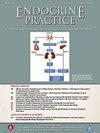A Pragmatic Approach to Monitor for Adrenal Axis Recovery After a Failed Short Synacthen Test
IF 4.6
3区 医学
Q2 ENDOCRINOLOGY & METABOLISM
引用次数: 0
Abstract
Objective
To identify a morning cortisol threshold value which confirms non-recovery of the adrenal axis and therefore negates the need for a short Synacthen test (SST) in those with known adrenal axis insufficiency.
Methods
We collected data from all SSTs (n = 1570 tests; n = 952 individuals) conducted in our hospital over a 10-year period spanning between 1st February, 2013, and 30th January, 2023. We included all tests where baseline cortisol levels were taken before 9:30 am Both 30- and 60-minute cortisol values were measured. Cortisol was measured using the Abbott Architect method. We used the full SST dataset to construct a quantile regression model to predict the 95% centile of peak cortisol response. This model was refitted to the SST follow-up data for those who failed a first SST (n = 115 tests; n = 66 individuals) to identify the baseline cortisol value below which there was a less than 5% chance of passing an SST.
Results
Those with an early morning cortisol of ≤126 nmol/L had ≥95% chance of failing an SST. Sixty percent of follow-up SSTs (69/115) exhibited baseline cortisol values below this threshold, and none of these passed an SST.
Conclusion
An early morning cortisol ≤126 nmol/L is common in those followed for adrenal axis recovery and is an accurate indicator of non-recovery. Baseline cortisol measurements are therefore a simple way of screening for adrenal axis recovery. Those with a cortisol of >126 nmol/L should go on to have an SST. Using this approach could considerably reduce the need for follow up SSTs in this patient cohort.
短同步试验失败后监测肾上腺轴恢复的实用方法。
目的:确定确认肾上腺轴未恢复的早晨皮质醇阈值,因此否定了在已知肾上腺轴功能不全的患者中进行短Synacthen试验(SST)的必要性。方法:收集所有SSTs的数据(n= 1570例;N =952人)于2013年2月1日至2023年1月30日期间在我院进行。我们纳入了所有在上午9:30之前测量基线皮质醇水平的测试。测量了30分钟和60分钟的皮质醇值。使用Abbott Architect方法测量皮质醇。我们使用完整的SST数据集构建了一个分位数回归模型来预测峰值皮质醇反应的95%百分位数。该模型被修正为第一次海表温度测试失败者的海表温度随访数据(n=115次测试;n=66个人)来确定基线皮质醇值,低于该值,通过SST的机会小于5%。结果:清晨皮质醇≤126 nmol/L的患者发生SST失败的几率≥95%。60%的随访SST(69/115)显示基线皮质醇值低于该阈值,没有一个通过SST。结论:肾上腺轴恢复随访患者清晨皮质醇≤126nmol/L较为常见,是肾上腺轴未恢复的准确指标。因此,基线皮质醇测量是筛选肾上腺轴恢复的一种简单方法。皮质醇为126nmol /L的人应该会有SST。使用这种方法可以大大减少该患者队列中SSTs随访的需要。
本文章由计算机程序翻译,如有差异,请以英文原文为准。
求助全文
约1分钟内获得全文
求助全文
来源期刊

Endocrine Practice
ENDOCRINOLOGY & METABOLISM-
CiteScore
7.60
自引率
2.40%
发文量
546
审稿时长
41 days
期刊介绍:
Endocrine Practice (ISSN: 1530-891X), a peer-reviewed journal published twelve times a year, is the official journal of the American Association of Clinical Endocrinologists (AACE). The primary mission of Endocrine Practice is to enhance the health care of patients with endocrine diseases through continuing education of practicing endocrinologists.
 求助内容:
求助内容: 应助结果提醒方式:
应助结果提醒方式:


